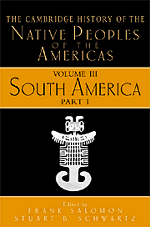Book contents
- Frontmatter
- Contents
- List of Illustrations
- Introduction
- 1 Testimonies: The Making and Reading of Native South American Historical Sources
- 2 Ethnography in South America: The First Two Hundred Years
- 3 The Earliest South American Lifeways
- 4 The Maritime, Highland, Forest Dynamic and the Origins of Complex Culture
- 5 The Evolution of Andean Diversity: Regional Formations (500 B.C.E.–C.E. 600)
- 6 Andean Urbanism and Statecraft (c.E. 550–1450)
- 7 Chiefdoms: The Prevalence and Persistence of “Señoríos Naturales” 1400 to European Conquest
- 8 Archaeology of the Caribbean Region
- 9 Prehistory of the Southern Cone
- 10 The Fourfold Domain: Inka Power and Its Social Foundations
- 11 The Crises and Transformations of Invaded Societies: The Caribbean (1492–1580)
- 12 The Crises and Transformations of Invaded Societies: Andean Area (1500–1580)
- 13 The Crises and Transformations of Invaded Societies: Coastal Brazil in the Sixteenth Century
- Index
12 - The Crises and Transformations of Invaded Societies: Andean Area (1500–1580)
Published online by Cambridge University Press: 28 March 2008
- Frontmatter
- Contents
- List of Illustrations
- Introduction
- 1 Testimonies: The Making and Reading of Native South American Historical Sources
- 2 Ethnography in South America: The First Two Hundred Years
- 3 The Earliest South American Lifeways
- 4 The Maritime, Highland, Forest Dynamic and the Origins of Complex Culture
- 5 The Evolution of Andean Diversity: Regional Formations (500 B.C.E.–C.E. 600)
- 6 Andean Urbanism and Statecraft (c.E. 550–1450)
- 7 Chiefdoms: The Prevalence and Persistence of “Señoríos Naturales” 1400 to European Conquest
- 8 Archaeology of the Caribbean Region
- 9 Prehistory of the Southern Cone
- 10 The Fourfold Domain: Inka Power and Its Social Foundations
- 11 The Crises and Transformations of Invaded Societies: The Caribbean (1492–1580)
- 12 The Crises and Transformations of Invaded Societies: Andean Area (1500–1580)
- 13 The Crises and Transformations of Invaded Societies: Coastal Brazil in the Sixteenth Century
- Index
Summary
As a European historian has observed, historians “have a soft spot for conquest,” which provides a neat, defined chronology in which to fit an intractable past. That is particularly true in the Americas, where the conquest of the native states has been generally accepted as marking the beginning of modern history. But conquests can provide only a chronology for the winners, for like many defining “events,” they become clear only with the passage of time, and only as long as they are seen from a single perspective. The Spaniards who moved into the Andes in 1531 regarded themselves as conquerors, and their own versions of what happened in the region between that date and the 1560s remains unchallenged. After all, after 1532, it became impossible to deal with the region without taking into account the European presence. The Andes became part of an expanding Europe, and more specifically, of the Spanish empire, the most powerful European political structure of the sixteenth century (Map 12.1). But it would be very poor history to view the events of the sixteenth century through the focus of the twentieth, and to assume the absolute victory of Spaniards over Andeans simply because, centuries later, the relationship between people who defined themselves as European and people who were defined (and often defined themselves as well) as Andean was one of almost total domination of the latter by the former.
The pages that follow attempt to examine the period from 1500 to 1580 – the period usually classified as the Spanish conquest – from a somewhat different perspective. The task is not easy because the appearance of the Spaniards in the Andes also means that the sources for the study of the region change massively. Before 1531, the only direct records available to a student of Andean history are those read by archaeologists; the Europeans who came to the Andes after 1532 generated the kind of record used by scholars who traditionally depend upon written materials. That change is both useful and misleading, because the standard bias of the written word, which is a bias toward the view of an élite, is multiplied by the fact that all our data about Andean people undergoes a process of translation and interpretation through a different culture. Even sources generated by Andeans are constrained by the differences between oral and written traditions.
- Type
- Chapter
- Information
- The Cambridge History of the Native Peoples of the Americas , pp. 904 - 972Publisher: Cambridge University PressPrint publication year: 1999
- 35
- Cited by



